Why Should You Feature User-Generated Content on Your Shopify Store?
When it comes to persuading customers to make purchases from your brand, trust is key. So how can you effectively build the credibility of your business? By making use of your customers’ most trusted source; other people.
Read on to find out what user-generated content really means and how you can use it to enhance your brand’s reputation, drive more customers to your store and ultimately boost your sales.
Written By
Esther Lowde

What is user-generated content?
Essentially, user-generated content refers to any form of content created by website visitors or customers that is made available publicly on a company’s website.
From live Twitter hashtag streams to video reviews and written testimonials, there are a variety of different types of user-generated content available to your business, all of which – when used correctly – can become some of the most powerful marketing tools your company possesses.
To help you get started, let’s take a look at the advantages of each type of UGC.
Product reviews
Enabling your customers to leave detailed reviews on your product pages is a sure way to increase your brand reliability and the likelihood of visitors buying from your store.
In fact, according to BrightLocal, 85% of customers trust online reviews as much as personal recommendations, and featuring reviews on your website has been shown to produce an 18% uplift in sales on average.

Importantly, you can also use these written reviews as powerful marketing tools by posting them on your brand’s various social channels and featuring positive review snippets on your homepage so that your visitors are instantly greeted by recommendations from others from the moment they enter your website.
With all of the advantages that product reviews can offer ecommerce businesses, there really is no reason not to be making use of this affordable and effective feature on your store.
Even risking the occasional negative review on your website will not have a damaging effect on your business overall. In fact, it will actually likely establish your brand’s credibility and trust as 68% of customers say that they are more likely to believe that a company’s reviews are legitimate when they see both positive and negative ratings.
So which apps do we recommend for text-based customer reviews?
Stamped is one of our favourites as it is inexpensive but highly effective and a good fit for most general Shopify stores.
However, for specifically fashion-based ecommerce stores, Okendo is also a strong choice as it allows users to leave multi-layered reviews in which they can review multiple aspects of a product (such as the fit, the quality and the colour) at once.
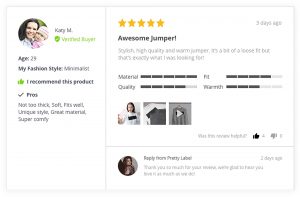
Example of a review left by an Okendo user, demonstrating customers’ ability to rate different aspects of a product.
Photo reviews
However, in a digital landscape ruled by visual content, text-only reviews may not quite cut it any more. Instead, more online stores than ever are featuring photo and video reviews from customers on their websites.
To find out more about this increasingly popular ecommerce trend, we asked Vera Smirnoff, Marketing Director at leading photo review app company Loox, to share some of her knowledge about the growing importance of visual reviews for online stores:
What makes photo reviews so effective?
“Our data here at Loox shows that products with customer reviews have a 26% higher conversion to checkout than products with no reviews, and products with customer reviews that include photos increase conversion by up to 91% (!) in some cases.
This is because when it comes to reviews, visual cues such as photos and images are extremely important. Our brains are hard-wired to process visual data, including colours and images.
Ecommerce retailers are already aware that visual content such as photo reviews is an extremely valuable tool and sharing it is indispensable for their marketing efforts, but not many realize why it’s so important.
Visual content reaches an individual’s brain in a faster and more understandable way than textual information. Images evoke emotions, which are a crucial component of our decision-making process.
Reading textual reviews, on the other hand, requires conscious effort. It also takes our brains longer to process text-based or verbal information, while the time it takes to process visual content is 0.25 seconds.
So the bottom line is – before the visitor even gets to reading the textual reviews on your site, they often have already made up their minds about whether to trust your brand or not based on visual cues alone.
They will proceed to reading textual reviews to solidify their decision only after the initial assessment of whether to trust your brand or not has already been made.”
What other factors influence the effectiveness of customer reviews?
“The effect that customer reviews have on a company’s sales depends on many factors, including reaching a ‘critical mass’ of reviews for each product.
Analysing over 100,000 product pages from over 4,000 Shopify stores, we’ve discovered at Loox that once you’ve reached 10 reviews per product, the conversion increase stabilizes at a little over 30%.
Recency of reviews is another important factor. Shoppers feel more confident that a store is active and will deliver on its promise when they see recent reviews. Having an ongoing stream of reviews also provides fresh content that improves SEO, driving high quality traffic to product pages.
So stores that have an automated review generation process in place have a significantly higher conversion boost than those that neglect to take full advantage of it.
Review request emails usually have high open rates. Based on over 2 million review request emails we have sent out last month, the average open rate reached 36%. This presents a great opportunity for merchants to upsell happy customers and generate repeat business.
Many of our customers have more than doubled their sales by taking advantage of this feature.”
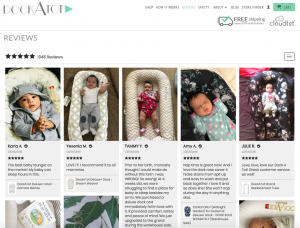
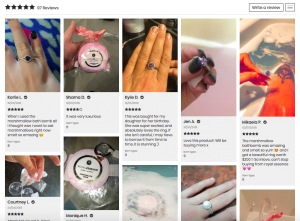
Examples of ecommerce stores DockATot and Royal Essence using the Loox app to showcase customer reviews in beautiful galleries on different pages of their websites; on a dedicated review page (top) and at the footer of a product page (bottom).
Video testimonials
Perhaps the most detailed and honest customer source of all, video testimonials are another sure way to appeal to your customers’ visual nature while increasing their trust in your brand.
Featuring video reviews on your website – either by allowing customers to upload them to your product pages or by sharing any existing video reviews uploaded to YouTube – is also a major sales-booster for your company.
In fact, according to recent studies, website visitors are also 64% (!) more likely to buy a product from an online retail website after watching a video of it.

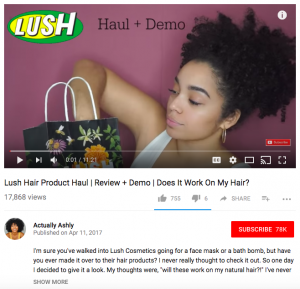
Examples of highly viewed customer video testimonials uploaded to YouTube.
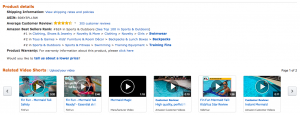
Example of a featured video reviews section for a children’s toy sold on Amazon.
To make the most of this powerful customer-generated material, you could even get creative and compile your buyers’ positive video reviews into an advert or a featured homepage video for your company.
Studies show that UGC-based ads like this have a click-through rate that is four times higher than purely professionally-sourced material, meaning that they are the perfect opportunity for ecommerce retailers to increase brand awareness without losing any of the customer-focussed authenticity of their store.
Customer-sourced social media photos
There are also a multitude of benefits to integrating user-generated social content into your ecommerce store.
Firstly, as we’ve established, customers love authenticity.
In fact, 77% of customers state that they are more influenced by authentic customer-focussed photos when shopping than by professional campaign images. Seeing others endorsing a brand or enjoying its products is therefore guaranteed to increase a potential buyer’s trust in the credibility of your business.
Featuring others’ social posts rather than solely featuring your own updates and images will also save you time on creating frequent original content, and will provide you with fresh new marketing material that is completely unique and one-of-a-kind.
Moreover, due to its memorability, frequency and originality, your customers’ social media content is more likely to be indexed and ranked highly by search engines, meaning your website can be found more easily by customers typing in relevant keywords to Google.
So how do you go about incorporating your customers’ posts into your website?
Walls is one app we recommend for collecting, selecting and displaying your customers’ hashtagged social media updates. This tool allows you to curate the content you want displayed on your website and embed it as an attractively laid out widget on your online store.
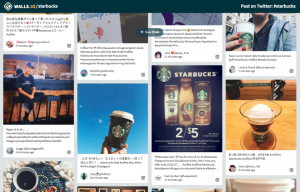
Example of a Twitter feed created using Walls to showcase Starbucks’ customers hashtagged posts and images.
One way of creatively incorporating UGC into your website using a tool like this is by asking your followers to submit images of themselves using or wearing your products so that you can then use their submissions to create a shoppable online catalog for your customers.
As UGC is 20% more influential on purchase decisions than all other media types, this customer-centric feature is an ideal component of any brand’s sales strategy and will also keep your followers happy and engaged as they enjoy their moment in the limelight.
Plus, studies have shown when a user has been a part of producing content for a brand, they are much more likely to stay loyal to them and continue shopping from that store.
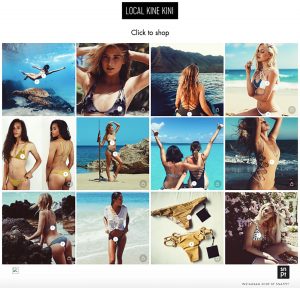
Example of a shoppable Instagram lookbook created using the Snapppt app.
Hashtag campaigns
Why not make the most of UGC as a tool for increasing brand awareness by creating a hashtag campaign to encourage your customers to engage and collaborate with your brand even more?
For an example of the benefits that using this technique can bring your business, take a look at popular fashion store Aerie’s UGC campaign #AerieReal:
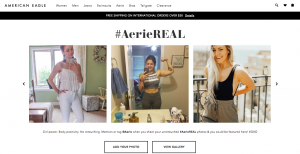
With this campaign, Aerie encouraged their customers to challenge the media trend of retouched and airbrushed photos in the fashion industry by sharing untouched photos of themselves.
In exchange, Aerie promised to donate $1 to the National Eating Disorders Association for every photo submission they received, as well as giving their customers a featured space on their website.
This campaign benefited Aerie’s brand in a variety of ways.
Not only did they successfully boost their sales by spreading the word about their products, but they also made a positive difference to the world and increased their customer appeal as a company who support important causes.
You can also increase the appeal of your hashtag campaigns – and so spread the word about your business even more – by turning them into a social media contest, as avocado-centric brand Love One Today demonstrated with their #AvoFruitFull competition:
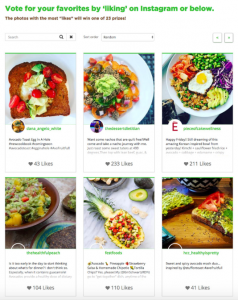
This creative hashtag campaign encouraged the company’s followers to share pictures of how they were using fresh avocados in their recipes to be in a chance with winning one of 23 delicious food-based prizes.
The more likes and votes that their followers’ featured Instagrams received, the more likely they were to win. This incentive motivated more users to engage with the brand and so inspired others to buy the brand’s fresh avocados in order to recreate the recipes that they had seen their friends sharing.
The bottom line
Clearly, giving your customers the chance to hear not only from your brand but also from unbiased people just like them is the most effective form of optimising and marketing your online business.
And the best part? It will cost you almost nothing!
With so many easy-to-use tools for incorporating user-generated content into your website at your fingertips – and such strong evidence of the wonders that customer-created content could do for your sales – the question shouldn’t be whether or not you should be making use of user-generated content but which type your brand is going to feature first.

